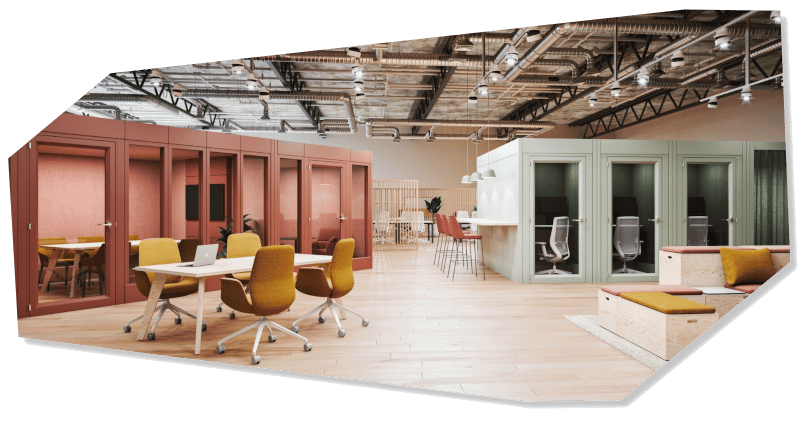The changing face of the office – Drivers for change
The workplace has been in the spotlight more than ever in recent years. Over the course of the pandemic, organisations rushed to implement remote and home working solutions, which over time gradually transformed into hybrid working.
More recently, the office has seen a revival as a hub, not just for close collaborative working and visibility across the business for the management team, but also as a supportive space for workers, many of whom had become isolated over long periods of home working.
Younger workers in particular miss out on the social and mentoring opportunities the workplace provides, as well as the buzz of a shared space that provides a vital opportunity for businesses to embody their brand ethos and values.
There’s no doubt the office is here to stay – although the shape of it is continually changing. With these upheavals in working patterns taking place over the last few years, many businesses have exited the pandemic feeling that their existing workspace is no longer fit for purpose.
Harnessing new ways of working
Businesses have changed the way they work in the last few years, with many adopting models of hybrid and location-independent working and leveraging new technologies to enable people to work how, where and when they choose.
Although the rise in new ways of working has been driven in part by the pandemic, many have discovered a host of additional benefits, including improved collaboration and productivity, reduced operating costs, reduced time lost to commuting, and improved carbon footprint to name a few.
This provides a huge opportunity for organisations to rethink their physical workspace, with the move away from 1:1 staff-to-desk ratios towards agile and activity-based work settings meaning that the amount of space a business needs, and the way that space is used, can dramatically change.
All change
Rethinking the way you work and the spaces, technologies and work settings that support your business can help you become more innovative, competitive and adaptable. The question is – should you stay and remodel your existing space, or look for somewhere new? In this guide, we help you navigate that decision, weighing up the key drivers and factors you need to take into account.
Understanding the drivers for change
Organisations rarely invest in dramatic workplace change without a compelling underlying reason. Considering the time, resources and potential disruption involved, it’s a serious decision that is always driven to a large extent by necessity.
Workplace change is usually a response to a change in the wider business and the context in which it operates. These changes generally fall into one of three broad categories:
- Organisational drivers
- Property drivers
- Financial drivers
Your reasons for change may fall into more than one of these categories, and it’s important to understand how these different drivers interact with one another.
Organisational drivers
One of the foremost reasons for workspace change is when the organisation changes, and the current space no longer suits your needs. This can happen when a business goes through a period of rapid growth or downsizing, when a merger or acquisition is taking place, or when the business restructures or adopts new ways of working – such as agile, activity-based or hybrid working.
Mapping the details of your organisational change is vital to enabling you to make an informed decision about how your workspace needs to change. There may be an imperative to move – for example if relocation is an unavoidable part of a merger or restructure. On the other hand, there may be compelling reasons to adapt your existing space – for example when transitioning to a new way of working that can’t wait until the next lease event.
Understanding the details of the required changes, being able to put different needs in priority order, and put a timeline to proposed changes, is the first step in the decision-making journey.
Financial drivers
Sometimes workspace change is driven by financial imperatives. If a business is looking to rationalise costs, evaluating property needs is one way to reduce unnecessary expenditure. What’s most important here is a comprehensive cost-benefit analysis, taking into account all the implications of your decision.
You may assume that moving office will be more expensive than staying put and remodelling, but that isn’t always the case. There may be opportunities to move to a more affordable location that still provides everything you need. On the other hand, you may be able to reduce costs by handing back some of your existing space to the landlord, or even subletting or running a coworking space.
In this case, it’s worth speaking to commercial property agents to find out what your options are, as well as consulting with workspace consultants to weigh up the comparative costs of remodelling your current space versus the move to a new space.
Property drivers
Sometimes workspace change is driven by an external factor – namely, an upcoming lease event. Lease breaks or expiries represent an opportunity for both the landlord and the tenant to assess the situation and decide whether it’s still working for them.
You may find that changes to the property market mean a change in costs going forward, or that a lease break represents an opportunity to renegotiate more favourable terms. You may be prompted to take a close look at how much space you really need, and weigh up whether to take on more, give back some space, or potentially sublet to generate revenue.
In this case, the ideal timeframe to start thinking about your options is at least 18 months before your lease break or expiry – and preferably longer. You will need to take into account the costs and incentives for staying or moving, whether you need more or less space, and any changes being driven by the landlord. It’s also worth taking legal advice as to your rights and obligations.
In our next blog, we’ll take a look at a key decision you may be facing in rethinking your office space – whether to stay put or move to a new location.
How Office Workspace can help
We can help you to take the first steps on your journey to a more productive, effective and engaging workplace. It’s as simple as having an informal chat with one of our workspace team, to find out a bit more about your business and your drivers for change.
To find out more about how we can help you to innovate the way you work, get in touch by emailing hello@officeworkspace.com or calling +44 (0)20 8039 0000. You can also fill out our online contact form, and we’ll get back to you as soon as possible.

